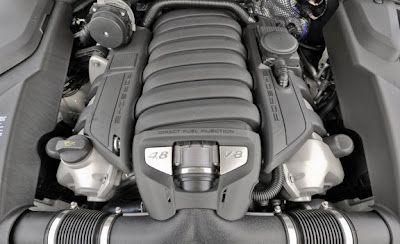How could a company that used to manufacture 911 lug nuts out of aluminum to save a few grams introduce an SUV whose weight in some versions approached 6000 pounds even though it could barely hold five adults?
Despite the disapproval of many Porschephiles, as well as most Car and Driver staffers, the Cayenne turned out to be a big success, selling more than 280,000 copies worldwide since its introduction and nearly 90,000 in the U.S.
Porsche executives like to say that profits from the Cayenne have made possible the increasingly swift and sophisticated 911 models that have been introduced with some frequency over the past few years.
Despite the disapproval of many Porschephiles, as well as most Car and Driver staffers, the Cayenne turned out to be a big success, selling more than 280,000 copies worldwide since its introduction and nearly 90,000 in the U.S.
Porsche executives like to say that profits from the Cayenne have made possible the increasingly swift and sophisticated 911 models that have been introduced with some frequency over the past few years.
Bigger but Lighter
But with this second-generation Cayenne, Porsche has taken to heart many of the criticisms of the previous model. Most important, the company has taken about 400 pounds out of the Cayenne. About 70 pounds of that come from the elimination of the two-speed transfer case. Instead, the new model gets an eight-speed automatic with a lower first-gear ratio and more sophisticated traction control. About 65 pounds were found in other engine and powertrain reductions. Greater use of aluminum in the chassis yielded 72 pounds, lighter wheels and tires shaved 17 more, an electric parking brake dropped 13, and structural efficiencies eliminated 42 pounds.
A huge chunk of weight came out of the body, too, with 86 pounds eliminated through redesigned doors, 42 from a lighter interior, 22 from different electrical components, and 17 from various body-shell changes and other structural-attachment efficiencies. Despite these weight reductions, overall structural stiffness was increased by 15 percent, says Porsche.
Those agile at mental arithmetic will have noticed that these reductions add up to somewhat more than the claimed weight reduction. The difference between that figure and the actual reduction is additional content and reinforcement that had to be added in order to meet various legal requirements. Reducing a vehicle’s weight while adding content is quite an achievement.
Porsche engineers also managed to grow the Cayenne slightly in the process. The wheelbase is 1.6 inches longer, and the body has been lengthened by 1.9 inches. Combined with a rear seat that has an adjustable seatback angle and moves fore-and-aft over a range of 6.3 inches, there’s now plenty of room for four six-footers in the Cayenne. Cargo space is about the same as before.
Contrary to its slight size increase, the new model looks slightly smaller and tidier than its predecessor. It retains the main Porsche cues—front fenders slightly higher than the hood, which is rounded in the front; air intakes rather than any kind of radiator-like shell; and pronounced rear shoulders—but the body panels are smoother and neater than before. Despite the sleeker look, the drag coefficient is essentially unchanged at about 0.36.
Inside, the improvement is overwhelming. The center console mimics the beautiful Panamera design with a neat array of buttons on an upward sloping panel. A new instrument cluster with a central tachometer and a customizable 4.8-inch TFT screen to its right provides all the primary information you need. In the usual Porsche fashion, the interior can be upgraded with leather swaddling just about everything, an Alcantara headliner, and five different trim options—you can check options boxes until you’re broke. After spending several hours in the new model, we think the old Cayenne looks plain and pedestrian inside.
Under the hood, the engines are largely carry-over, with the twin-turbo V-8 at the top of the line and the 3.6-liter, VW-derived V-6 at the bottom. But several powertrain upgrades serve to dramatically improve fuel economy. The most important is the switch from a six-speed to an eight-speed transmission. What this does is increase the spread of ratios between low gear and top gear from about 6:1 to 7.2:1. That means a lower first gear to help compensate for the loss of the dual-range transfer case, combined with a taller top gear for better fuel economy on the highway.
Interestingly, Porsche didn’t use its twin-clutch transmission—PDK in Porsche speak—on the Cayenne because the vehicle is so heavy and has substantial towing capacity. The company told us the clutches on the PDK would have a hard time with a combined load north of 9000 pounds. Porsche also says—and we can believe—the torque-converter automatic provides greater sensitivity and control in delicate off-road driving.
Further fuel-economy improvements come from the addition of automatic stop/start, which turns off the engine when you’re stopped. Then there are redesigned cooling systems to provide shorter warm-up times, optimized engine calibrations, smart charging to engage the generator during deceleration as much as possible, and tires with 10-percent-lower rolling resistance. Combined with the weight reduction, these changes result in a substantial 20-to-23-percent improvement in fuel economy based on European test figures.
New Hybrid Model
There’s also the addition of the new hybrid model, badged “Cayenne S Hybrid.” It has a different gasoline engine than any of the other models—the supercharged 333-hp, 3.0-liter V-6, borrowed from the Audi S4. A 47-hp electric motor/generator shaped like a six-inch-thick, 12-inch-diameter disk is sandwiched between this engine and the eight-speed automatic gearbox. A small 288-volt nickel-metal hydride battery pack sits under the luggage compartment along with the electronics to control the flow of power from the battery to the motor/generator and back. Learn More...
Source : http://www.caranddriver.com




 Friday, June 24, 2011
Friday, June 24, 2011







 Posted in:
Posted in: 




0 komentar:
Post a Comment